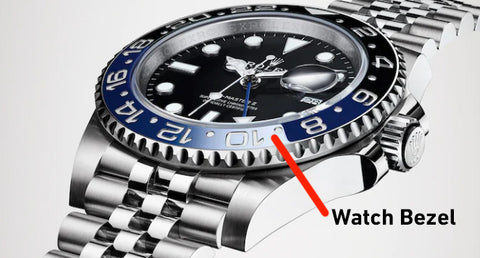Introduction
When you look at a watch, you might notice a ring encircling the dial, often marked with numbers, indices, or other markings. This component, known as the watch bezel, plays a crucial role in both the functionality and aesthetics of a timepiece.
The Basics of a Watch Bezel
Functionality
At its core, a watch bezel serves several practical purposes:
-
Time Measurement: In many diver's watches and aviation watches, the bezel is equipped with minute or hour markers. By rotating the bezel, wearers can track elapsed time or set countdowns for specific tasks.
-
Protection: The bezel can safeguard the watch crystal by slightly raising it above the case. This design helps prevent scratches and impacts from directly hitting the crystal.
-
Aesthetics: Bezels come in various styles and materials, enhancing a watch's overall appearance. From sleek and minimalist to rugged and functional, bezels contribute to a watch's character.
Types of Bezels
There are several types of bezels commonly used in watchmaking:
-
Fixed Bezel: This type is stationary and doesn't rotate. It typically features markings for aesthetics rather than functionality.
-
Rotating Bezel: Often seen in diver's watches, this bezel can be rotated in one direction. It allows wearers to monitor dive times or measure elapsed time for various activities.
-
Bi-Directional Bezel: Unlike the unidirectional bezel found in many dive watches, this bezel can be rotated in both directions. It's commonly used in aviation watches for calculating fuel consumption, among other tasks.

(The Bezel Of A Watch)
Materials and Design
Bezels can be made from a variety of materials, including stainless steel, ceramic, aluminium, and even precious metals like gold. Each material offers its unique blend of durability and aesthetics.
In terms of design, bezels range from plain and functional to intricately crafted works of art. Some bezels are adorned with gemstones, while others display technical calculations or a minimalist, clean look.
Conclusion
In the world of horology, the watch bezel is far more than a decorative ring; it's a multifunctional element that adds both form and function to timepieces. Whether you're tracking time underwater, in the air, or on land, the bezel is a key feature that enhances the watch-wearing experience. So, the next time you glance at your wrist, take a moment to appreciate the subtle yet essential role of the watch bezel.
Understanding the watch bezel opens up a world of horological knowledge and appreciation, allowing you to fully engage with your timepiece on both a functional and aesthetic level. So, whether you're a seasoned watch enthusiast or just beginning your journey into the world of watches, you now have a clearer understanding of this essential watch component.
Frequently Asked Questions
1. What are the numbers on a watch bezel for?
Watch bezel numbers are typically used for tracking elapsed time or performing calculations, depending on the watch's purpose. They provide a reference point for aligning with the watch's hands or other markers.
2. What are the types of watch bezel?
Watch bezels come in various types, including fixed bezels (non-rotating), rotating bezels (unidirectional or bidirectional), countdown bezels, slide rule bezels, and tachymeter bezels. Each type serves specific functions.
3. What is a rotating bezel on a watch?
A rotating bezel is a bezel that can be turned either clockwise or counterclockwise. It's commonly found on dive watches and can be used to track elapsed time underwater.
4. How to use watch bezel?
The use of a watch bezel depends on its type. Rotating bezels can be used to measure elapsed time, while slide rule bezels assist with calculations. Countdown bezels help track time remaining.
5. What is a watch bezel used for?
A watch bezel serves various functions, including measuring time intervals, performing calculations (e.g., with slide rule bezels), and enhancing the watch's aesthetics.
6. What is the purpose of a rotating watch bezel?
The purpose of a rotating watch bezel, especially on dive watches, is to track elapsed time underwater. By aligning the bezel's marker with the minute hand, divers can monitor their dive time.
7. What is a watch bezel insert?
A watch bezel insert is a piece that fits inside the bezel and often includes markers or scales. It can be made of various materials and serves both functional and decorative purposes.
8. How to use dive watch bezel?
Dive watch bezels are typically unidirectional and used to measure dive time. Before diving, align the bezel's marker with the minute hand. As time passes, you can read the elapsed time on the bezel.
9. How to remove watch bezel?
Removing a watch bezel is a delicate task that requires watchmaking expertise. It usually involves carefully detaching the bezel from the watch case without damaging the watch's components.
10. How to lubricate watch bezel?
Lubricating a watch bezel is a precision task best left to professional watchmakers. They use specialised lubricants to ensure smooth rotation and longevity.
11. How to use GMT watch bezel?
GMT watch bezels are used to track multiple time zones. They work in conjunction with the watch's GMT hand. By adjusting the bezel and GMT hand, you can read the time in different locations.
12. How to measure watch bezel size?
Measuring watch bezel size typically involves determining its diameter. You can use a caliper or ruler to measure the bezel's outer edge.
13. What is a countdown bezel?
A countdown bezel is a specialised rotating bezel often found on dive watches. It allows the wearer to set a specific time duration, such as the length of a dive, and visually track the time remaining.
14. Do all dive watches have rotating bezels?
While many dive watches feature rotating bezels for tracking dive times, not all dive watches have this feature. Some modern dive watches incorporate digital displays or alternative methods for measuring elapsed time underwater.
15. Can a rotating bezel be used as a makeshift compass?
Yes, in some situations, a rotating bezel can be used as a rudimentary compass. By pointing the hour hand at the sun (in the northern hemisphere) or the 12 o'clock position (in the southern hemisphere) and bisecting the angle between the hour hand and the 12 o'clock position, you can estimate north.
16. Are there watch bezel protectors available?
Yes, some watch enthusiasts use bezel protectors, which are additional accessories designed to safeguard the bezel from scratches and impacts. These protectors are particularly common for dive watches and rugged sports watches.
17. What is a watch bezel made of?
Watch bezels can be made from various materials, including stainless steel, ceramic, aluminium, precious metals like gold, and even high-tech materials like carbon fibre. The choice of material affects durability, aesthetics, and functionality.
18. What's the history of rotating bezels in watches?
Rotating bezels in watches have a rich history, with origins in early dive watches for tracking dive times. Over time, their functionality expanded to include various timing and measurement functions. Today, they are a common feature in both sports and tool watches.
19. Do women's watches have the same types of bezels as men's watches?
Women's watches can have a variety of bezel styles, just like men's watches. The choice of bezel type often depends on the watch's intended use and design, rather than gender-specific factors.
20. Are ceramic bezels better than metal ones?
Ceramic bezels are highly scratch-resistant and offer excellent durability. They are often preferred in dive watches for their resistance to corrosion. However, the choice between ceramic and metal bezels depends on personal preferences and the intended use of the watch.
21. Can you explain a slide rule bezel on a pilot's watch?
A slide rule bezel on a pilot's watch is a specialised feature that allows pilots to perform various calculations, such as fuel consumption, airspeed, and flight time. It's a valuable tool for aviation professionals.
22. Are there specific watches with no bezels?
Yes, some minimalist and modern watch designs feature no external bezels. These watches prioritise a sleek and uninterrupted appearance. However, their functionality may be limited in terms of time measurement.
23. Do vintage watches have different bezel styles?
Vintage watches often feature a wide range of bezel styles, depending on the era and intended use of the watch. Vintage watches are cherished for their unique and historical designs.
24. Can I change the bezel on my watch to alter its appearance?
Yes, you can often change the bezel on your watch to alter its appearance. However, this requires access to compatible replacement parts and watchmaking expertise. Customising a watch's bezel can offer a fresh and personalised look.










What Is A Watch Crown?
How To Spot A Fake RS Chrono Watch